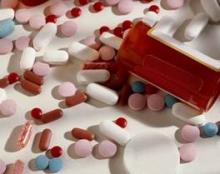Approximately 95% of visits related to medication poisoning in children younger than 5 years are caused by self-ingestion, based on data from nearly 500,000 emergency visits during 2001-2008, according to a study published online Sept. 16 in the Journal of Pediatrics.
"If we are to make progress in reducing childhood injury from pharmaceutical poisoning, we need to better understand the epidemic," said Dr. G. Randall Bond of the University of Cincinnati and colleagues.
The researchers reviewed case information from 453,599 children aged 5 years and younger who visited emergency departments due to possible medication poisoning via ingestion of a single product. Data were taken from the American Association of Poison Control Centers’ National Poison Data System, an electronic database of all calls to the organization’s member centers (J. Pediatr. 2011 Sept. 16 [doi:10.1016/j.jpeds.2011.07.042]).
Of the self-ingested poisonings, prescription products accounted for the largest percentage of ED visits (55%), hospital admissions (76%), and significant injuries (71%).
Opioid analgesics had the greatest increase in impact on health care resources during the study period – ED visits increased by 101%, injury rates increased by 92%, and hospital admission rates increased by 86%.
The findings were limited by the self-reported nature of the cases, but they support data from previous studies on the increasing numbers of emergency department visits by young children due to medication poisoning, Dr. Bond and his coauthors said. "The most likely explanation for these observations is a rise in the number of medications in the environment of small children," they noted.
These medications may be more accessible to children in the home because the number of opioid analgesic prescriptions has increased, according to data from the U.S. Drug Enforcement Administration’s database, the researchers noted.
When it comes to preventing medication poisonings, "the results of this study suggest that focus should shift to self-ingestion and prescription products," the researchers said. "The largest potential benefits would come from a shift in attention to packaging design changes that reduce the quantity a child could quickly and easily access in a self-ingestion episode," they added.
Of 90 unintentional deaths recorded in the database, 66 were ingestion related. Of these, opioid analgesic and cough medicines accounted for the most deaths (20).
Another recent study by Dr. Gary M. Vilke of the University of California, San Diego and colleagues provided a breakdown of more than 40,000 paramedic transport calls related to poisonings in children younger than 5 years between 2000 and 2007 (J. Emerg. Med. 2011;41:265-9).
In this retrospective study, more than half of the poisonings were due to ingestion of prescription or over-the-counter medications (56%). In addition, medications made up a majority of the poisonings in each age group: less than 1 year (40%), 1 year (46%), 2 years (66%), 3 years (68%), and 4 years (60%). The researchers also noted that 10% of the poisonings were caused by cosmetics. This study was limited by the use of a preexisting database and the inclusion only of cases in which poisoning was the chief complaint.
However, the findings reinforce the need for better education about the poisoning potential of household medications, as shown in the study by Dr. Bond and colleagues.
None of the researchers in either study had any financial conflicts to disclose.


